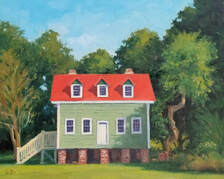 Hutchinson House, 8" x 10" Hutchinson House, 8" x 10" We are well into 2022 and I have not kept this blog up to date, as one day flows into another! I had a flurry of activity at the end of 2021 assessing, completing, photographing and framing the year's output of paintings. I had spent the year focusing on very small plein air and studio landscape scenes inspired by my surroundings and found I had more than 20 worthy of sharing with the public. Thanksgiving weekend I participated in a pop-up show with two dedicated artists from our small plein air group, which was a lot of fun. Then the director of the Edisto Island History Museum asked me if I would exhibit there for a few months, and I hung the paintings at the beginning of January. The exhibit at the Edisto Island Museum is hung "salon style" and contains about 18 small, framed paintings made in 2021 plus two larger ones. The artworks will be on view until May 22. The Museum is not large but contains significant artifacts and displays explaining the history of the Island from the time of the indigenous residents through slavery times, the Civil War and beyond. Some items belonged to my ancestors. Current open hours are Tuesday, Thursday and Saturday 1:00 to 4:00. Starting in March the hours will return to Tuesday through Saturday 12:00 to 5:00. The address is 8123 Chisolm Plantation Road. For more information or to purchase paintings online through their shop, go to Edisto Island Museum (edistomuseum.org).
0 Comments
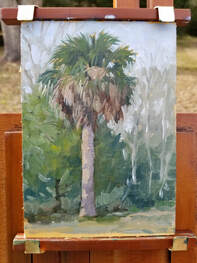 Palmetto study on the easel Palmetto study on the easel Just before the coming of this new year, a fellow artist invited me to participate in a challenge sponsored by the Strada easel company to paint or draw something from life (not photographs or imagination) each day for the month of January and post results to Instagram. Coincidentally, my husband gave me a fitness watch for Christmas and I signed up for a virtual training program to work up to running a 5K. I don’t think I’m the only artist to have experienced spells of artistic inaction due to feelings of lack of worthy ideas, getting stuck mid-way on a project, or loss of momentum due to distractions or events. Sometimes we need a push to keep the artistic flow going, or to get off the couch. I accepted the Strada challenge and it was a positive experience. It was freeing; I designated a couple of subjects and technical issues to work on and resolved not to allow self-criticism to interfere. While I don’t subscribe to the notion that art-making is primarily about emotional expression, my mood is better at the end of the day when I have spent time engrossed in the process of looking, analyzing and responding through drawing or painting, an added benefit to the technical practice. The Strada company makes portable easel equipment for painting in plein air. I managed to get outside for a few sessions, if not far from the house. In January the weather is not ideal, even in my Southern climate. There are hardy souls who paint in the snow, but a bit of wind and chilly temperatures drive me indoors. Unsurprisingly, still lives dominated the challenge feed. I applied my sensibility to that genre to put a slightly surreal cast on studies of eroded seashells from my extensive collection, “cheating” a bit with invented backgrounds. While I admire those who can complete a successful painting in one session, I was glad this challenge allowed participants to post stages of a work in process, since I was not always able to overcome my meticulous nature and capture a subject alla prima. When time was too short to deal with oil paint, it was fun to fill a sketchbook page with drawings of our cats and share that. Now that the challenge month is over, I need to get back to completing projects that have been on hold and designing some larger paintings, so I won’t be posting something new online every day. But I plan to continue the good habits jump-started by holding myself accountable to a commitment. I will post some of the finished results from January on my Small Works and Studies portfolio page. (And yes, I have kept up with the running program!) 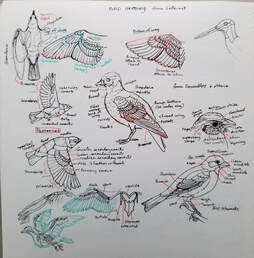 Sketchbook page, bird anatomy Sketchbook page, bird anatomy I've been living the rural life in South Carolina almost a year now, and it happens that for several of those months "social distancing" has been the recommended lifestyle anyway. Many people have commented that the safety rules resulting from the Covid-19 pandemic have brought them closer to nature as well as to home, which has given them some consolation and peace. My new home in the Lowcountry is ideal for that, and I am enjoying having nature observation opportunities as close as my front porch. I love animals of all kinds, and birds are especially fascinating. (I recommend the book Feathers: The Evolution of a Natural Miracle, by Thor Hanson, for as much as one could hope to know about the feather.) This is a rich environment for seeing birds, coastal species as well as woodland types. Several kinds of egrets, herons, laughing gulls, cormorants, etc. perch on our dock. A tall dead pine attracts eagles, osprey, vultures, wood storks, woodpeckers and owls. Bluebirds, pine warblers, Carolina wrens, painted buntings, mockingbirds, too many to count sing and flit around in the oaks, magnolias, palms and pines. I am just starting to learn about them and have a long way to go. Having done sketches from life and a few paintings that featured birds, I realized I needed to get a better grasp of their anatomy. Copying and drawing is the best way to learn! Here are a few pages from my sketchbook. 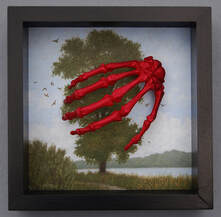 I moved to South Carolina last fall, and have now started forays into exhibiting on the East Coast. First up is the perfect opportunity to show one of my assemblage/painting pieces, an exhibit at the d'Art Center in Norfolk, Virginia, called "Eccentric: a National Exhibition of Surreal Artworks and Unconventional Materials". The co-curators, gallery manager Amanda Bradley and exhibition juror Alison Stinely, chose "Taking it With Us", a piece combining a glittery skeleton hand with a bucolic oil painting of a landscape in a shadow box (10" x 10" x 2 1/2"). After a delay due to the Coronavirus shutdown, the exhibit will be on view June 11 to 27, 2020. For more information, go to d'Art Center. 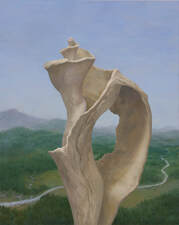 I was surprised to realize that my husband and I have been in Seattle for 20 years now. Living here has been a wonderful experience. The beautiful environment has been an inspiration for my art, and the people in the art community welcoming. I have participated in lots of exhibits at the Fountainhead Gallery and other spaces, and been impressed with the cultural scene here. In preparing to move back to the South and forge ahead with the next chapter in my life, I am enjoying pulling out of storage and reacquainting myself with paintings that didn’t find a buyer the first time around. Some have never been exhibited. I’m hanging them throughout the house and inviting art lovers to visit, browse and take advantage of this unique opportunity to purchase an artwork at a discount before I leave the Northwest. There will be a variety of sizes and subjects representing my various preoccupations. The larger paintings are framed or ready to hang, and I also have many unframed works for you to frame to suit your taste. I will have bins of figure studies to choose from, painted from the many lovely life models I have had the pleasure to work with. David and I will also offer for sale some artworks from our private collection, and artistic home furnishings and décor. Please contact me if you can’t make the event and would like a private showing. You can see some examples of artworks and prices here. Special Studio Sale: Sunday, July 14, 2019, 10 a.m. to 5 p.m. 1416 N. 35th St., Seattle WA 9810 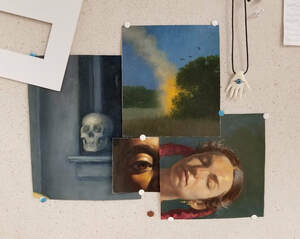 In anticipation of moving sometime within a year, I have been preoccupied, like many middle-aged people, with the familiar lament of how to winnow out possessions. Artists’ studios tend to fill up with not only finished and in-process artworks and art supplies of all types, but random inspirational objects and detritus that “may” come of use someday. With the current mania for minimalist lifestyles and Marie Kondo-style organizing in the zeitgeist, one can feel inclined to get rid of it all and return to the purity of the blank canvas. The hard part comes in finding new homes for objects and avoiding adding to the waste stream. Last year a friend told me about a Seattle organization called The Art of Saving Humanity that collects donated art supplies for the use of local immigrant and refugee artists. They have also mounted exhibits of the artists’ works. I was able to pass on to them many art supplies, used and unused, including a large set of pastels that had belonged to my grandmother. They also took a big batch of canvas-stretcher bars, frames, a folding easel and other items. I used to exhibit prints and other works on paper that had frames with sheets of glass, some quite large. I dismantled them and was thrilled to find a frame shop that took the glass, as it can’t go in the recycling bin. I posted a notice on Kelly’s Art List and gave away an antique French easel that had also belonged to my grandmother—feeling sad to do so, but glad someone else would use it, as I wasn’t. Even though I work slowly and have never been prolific, I find I have quite a few paintings in storage. I have been going through them with a critical eye and discarding those that don’t come up to my current standards. I keep representative drawings from different life stages, or those that have some special quality that makes me hesitate. It is still difficult to destroy a failed piece after spending an inordinate amount of time laboring on it. I remember being horrified as a freshman in college when an instructor described destroying an unsatisfactory drawing he had just spent eight hours working on (that seemed an awful lot of effort to me, then) and another telling the story of burning an entire year’s worth of work. To my younger self trying to build up a body of work, this was hard to imagine. Nowadays qualitative evaluation is easier, at least a few years after creation. If a large work on canvas is worth keeping, it can be taken off the stretcher bars and rolled for more compact storage. But some I have cut up and discarded, maybe keeping a few square inches of a well-executed portion as a memento. A few have found new life as backgrounds in my shadow-box assemblage pieces. I do have plenty of paintings in inventory that I am proud of, that didn’t sell when exhibited for whatever reason. Some are finding an enthusiastic audience and buyer at fund-raising auctions for art organizations and other worthy causes. A few others are finding homes after being offered for purchase to acquaintances in a targeted manner. I am not much good at business and marketing, having left sales to art galleries most of my career, but it is satisfying to match an artwork with an individual. (If anyone who happens to read this has been harboring a desire for a painting they saw in years past and wonders if it is still available, let me know!) The concept of having too much stuff brings up a painful issue—the dilemma of creating more unnecessary stuff (for art may be essential to an evolved society but not to sustain life) in a world that seems to have too much of everything and is running out of space to put it. I am a creative person and by nature feel compelled to make objects with my hands. Artists are advised to make lots of art, both to perfect their craft and to have plenty to bring to market. I have not gone overboard with this advice, but still sometimes fear I am contributing to an environmental crisis, and I worry that making more stuff is unethical. A few months ago, I brought up this doubt while attending a panel discussion on the habits of successful artists. Perhaps I didn’t phrase my question gracefully (I believe I used the word “crap” to refer to surplus art) but the artists sitting on the panel responded with something akin to outrage, as if even the topic was taboo, and quickly moved on. I guess as driven, self-confident artists this had never occurred to them. But at least one audience member came up to me afterward and told me of having the same concerns. Her solution had been to stop painting altogether and put her creative energies into writing. Many other artists are making art out of consumer discards, and exhibits devoted to recycling are becoming frequent. Then there are well-known artists like Andy Goldsworthy and John Grade whose sculptures are composed of, and degrade back into, the natural environment. It takes creativity to repurpose and to dispose of things in a thoughtful manner. Going forward I intend to be as mindful of avoiding waste in my studio as in my home, and try to make every mark on that blank canvas count. 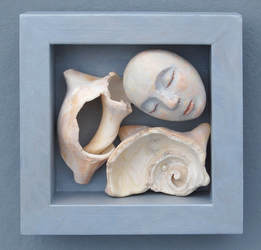 Keeping Secrets, 6" x 6" x 2" Keeping Secrets, 6" x 6" x 2" I am excited to be exhibiting my new type of artwork at Fountainhead Gallery in Seattle for the month of June. I will be exhibiting along with three other artists June 7 through 30, with an opening reception Saturday evening June 9 from 5 to 7 p.m. These new shadowbox artworks evolved from my desire to make something with my collection of natural objects. The eroded seashells, corals, limestone deposits and bits of driftwood that I pick up on the beach have such pleasing sculptural forms that I consider them works of art on their own. I was tempted to present them on pedestals with no artistic intervention. Removing the object from its original environment puts it into a new context and can generate appreciation for its abstract form, curiosity about what it is, and what its symbolic meaning is. In arranging and juxtaposing the objects I soon started to see them as players in a mysterious drama. My late mother was an accomplished artist who created paintings, sculptures, theatrical works and children’s books. Having studied at the acclaimed experimental art school Black Mountain College, she was constantly trying new techniques, despite the limitations of living in a small Southern town. Puppetry was a medium she had a love for since childhood, with which she could combine the skills of building the puppets and sets along with writing the plays. She eventually formed a troupe which traveled regionally, presenting her original works. As a teen I was prevailed upon one summer to perform one of her plays. While I admired my mother’s expressive style and have painted my own versions of one of her motifs, the broken conch shell, my own artistic temperament is more restrained and classically inclined than hers. Having thought of myself as a creator of two-dimensional art, I was surprised to find myself making constructions that could be seen as small theaters, with found and crafted objects acting as setting and characters. It felt entirely natural to sculpt small heads to include, and I recalled making puppets with the other children in a workshop my mother taught. The disembodied heads are not making their first appearance in my work. In the 1990s I was painting surrealistic scenes in which the egg-shaped, disembodied head represented the subconscious or dream state. It has a pleasing form and introduces a human element into a composition. In these new works, it represents a meditative state or a place to which the mind has traveled. In addition to the sculptural, natural and found elements, I am incorporating landscape painting as a backdrop in some of the constructions. I have primarily exhibited landscape paintings for several years. In the interest of recycling, in a few shadowboxes I use sections of older paintings. Creative re-use and a reluctance to add to the waste stream are growing concerns of mine. These works evolved organically into scenes from stories without words, involving the cycle of life, nature and psychic states. I will be interested to see what my audience thinks of them! 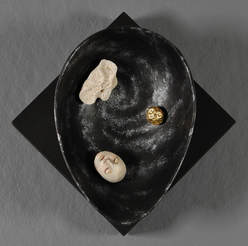 Juror Jody Bento, Director of SAM Gallery, selected my assemblage/sculpture piece "Orbit" for inclusion in the 2018 Center on Contemporary Art Members' Show, Creativity Persists. The show will be on display in CoCA's Pioneer Square gallery (114 Third Avenue South, Seattle, WA) from April 26 to May 26. It will open with a celebration during the Pioneer Square Art Walk on May 3 from 6 to 9 p.m. This will be a big show, chock-full of artwork in all disciplines from the Pacific NW and across the globe. Viewers will be able to vote for their favorites to be given one of two People's Choice awards. A printed catalog representing all CoCA members will be available for purchase. Click here to learn more about CoCA and the exhibit. I decided to delve further into this socially-connected 21st century and join the many artists and regular folks posting photos on Instagram. It's a fun place for a visually-oriented person, with many thousands of members from all over the world viewing and sharing images, sorted by a system about which I am still learning. I am looking forward to perusing images posted by museums and galleries as well as by friends, artists I admire and art lovers. As for myself, I intend to share works in progress, studio views, glimpses of my working process, tools, inspirations and freshly finished artworks. Since I still lack a smartphone, you aren't likely to be confronted by pictures of my food or face. Follow me here: Instagram.
My small oil and metal leaf painting "Flood" is included in a curated show at the Kirkland Art Center, and the image was used in promotional material. Show description: "Featuring artworks from the Pacific Northwest and across the country, the Kirkland Arts Center is proud to present the juried, group exhibition Re:Acclimating. Examining the topic of climate change through the lens of 23 artists working in a variety of media, Re:Acclimating addresses humanity’s impact on the environment."
The art center is located at 620 Market St., Kirkland, Washington, and the exhibit will be up until February 17. |
AuthorHere I will keep you up to date on my exhibits and other artistic endeavors. Archives
March 2024
Categories |
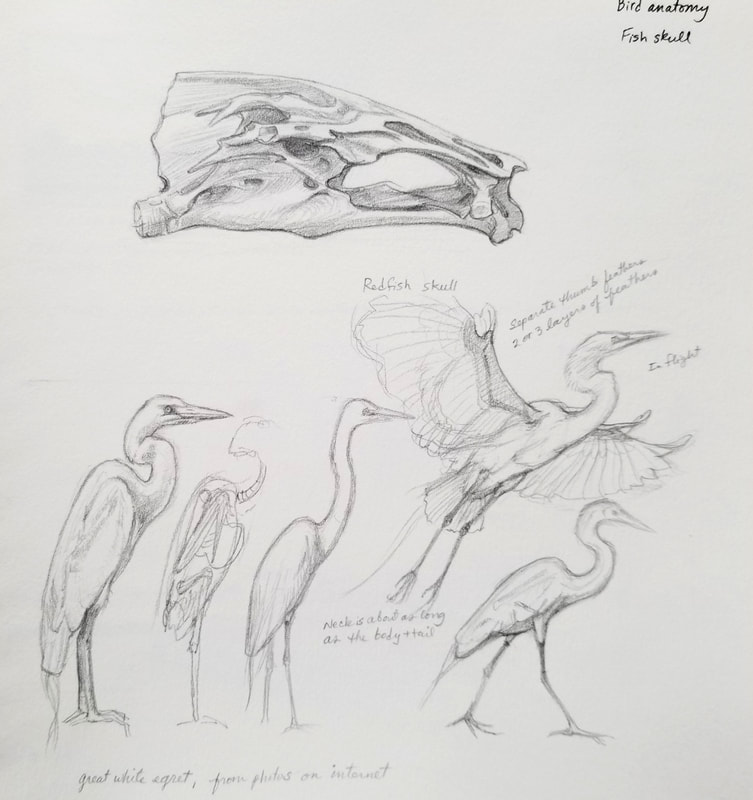
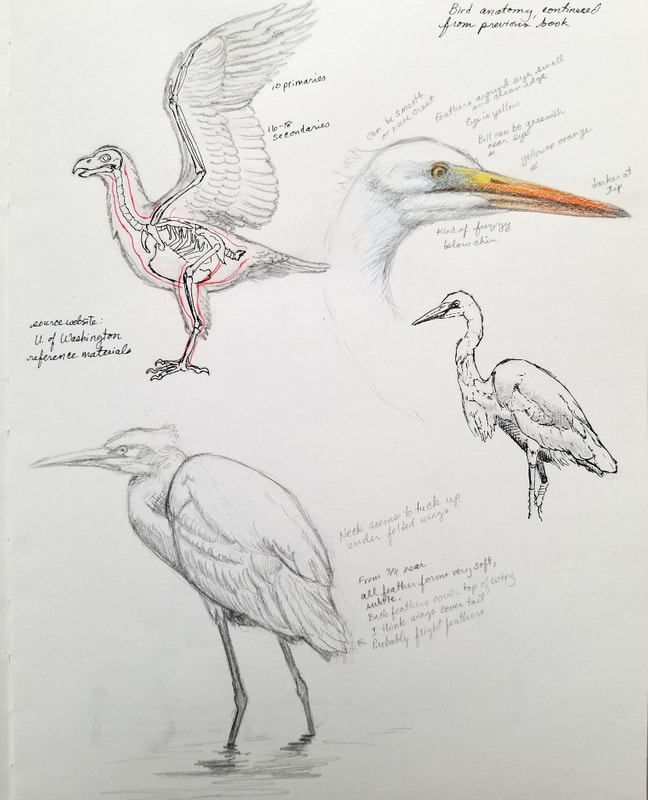
 RSS Feed
RSS Feed